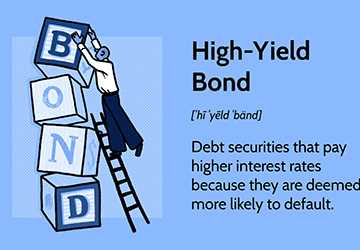What to Know About High-Yield Bond Investments
High-yield bond investments offer enticing returns, yet they also harbour elevated perils. Comprehending the intricacies of these investments is paramount for making wise decisions. This treatise provides essential high-yield bond investment tips, explores the best high-yield bonds, and delves into the rudiments of bond investing.

What Are High-Yield Bonds?
High-yield bonds colloquially denominated as junk bonds, offer superior returns due to their diminished credit ratings. These bonds are promulgated by corporations or entities with an augmented probability of default, necessitating higher interest rates to attract investors. Here are some high-yield bond investment tips to consider:
- Scrutinize the issuer's creditworthiness meticulously.
- Diversify your bond investments prudently.
- Vigilantly monitor interest rate vicissitudes.
Benefits and Risks of High-Yield Bonds
Engaging in high-yield bonds can be lucrative, but it is imperative to comprehend the intrinsic risks. Here’s a breakdown:
Benefits
- Higher Returns: One of the primary lures of best high-yield bonds is the potential for augmented returns compared to investment-grade bonds.
- Income Generation: They furnish a steady income stream, rendering them suitable for income-centric investors.
- Diversification: Incorporating high-yield bonds can enhance diversification and attenuate overall portfolio risk.
Risks
- Credit Risk: The heightened risk of default is a significant concern. Rigorous research and due diligence are indispensable.
- Market Volatility: High-yield bonds are more susceptible to market fluctuations.
- Liquidity Risk: These bonds can be less liquid than other investments, complicating the process of selling them expeditiously at a favourable price.
Best High-Yield Bonds to Consider
When seeking the best high-yield bonds, evaluating various factors, such as the issuer's financial health, bond ratings, and market conditions, is crucial. Here are some high-yield bond investment tips for identifying top-tier options:
- Seek bonds with a favourable credit outlook.
- Consider bonds from sectors with robust growth potential.
- Evaluate the bond’s yield relative to its risk.
Examples of Best High-Yield Bonds
1. Corporate Bonds: Promulgated by corporations with inferior credit ratings but higher interest rates.
2. Municipal Bonds: Certain municipal bonds proffer high yields, particularly those from financially beleaguered municipalities.
3. Emerging Market Bonds: Bonds from developing nations can offer high yields but entail increased risk.
Strategies for Investing in High-Yield Bonds
Diversification
A pivotal high-yield bond investment tip is diversification. You can attenuate risk and enhance potential returns by disseminating your investments across various bonds and sectors. Here's how:
- Invest in a heterogeneous mélange of bonds from sundry industries.
- Include bonds with divergent maturities and credit ratings.
- Contemplate bond funds or ETFs for instantaneous diversification.
Risk Management
Mitigating risk is crucial when investing in bonds, especially high-yield ones. Here are some strategies:
- Conduct exhaustive credit analysis of bond issuers.
- Scrutinize market conditions and adjust your portfolio accordingly.
- Set stop-loss orders to circumscribe potential losses.
Timing Your Investments
Timing can substantially impact your returns when investing in bonds. Here are a few high-yield bond investment tips related to timing:
- Invest when interest rates are stable or declining.
- Refrain from acquiring bonds during periods of elevated market volatility.
- Reinvest interest income to capitalize on compound accretion.
Common Mistakes to Avoid
When investing in high-yield bonds, it's critical to eschew common pitfalls. Here are some high-yield bond investment tips to help you avert missteps:
- Ignoring Credit Ratings: Always contemplate the bond’s credit rating and the issuer’s financial solvency.
- Lack of Diversification: Avoid allocating all your capital to a single bond or sector.
- Chasing High Yields: High yields often entail heightened risks. Balance your pursuit of returns with an assessment of risk.
Evaluating the Creditworthiness of High-Yield Bonds
Key Indicators of Creditworthiness
When analyzing high-yield bonds, it is paramount to scrutinize the issuer's creditworthiness meticulously. Here are some vital metrics and high-yield bond investment tips:
- Debt-to-Equity Ratio: A lower ratio signifies a salubrious balance sheet.
- Interest Coverage Ratio: Higher ratios denote the issuer's ability to cover interest payments adequately.
- Credit Ratings: Leverage ratings from agencies like Moody's, S&P, and Fitch for exhaustive insights.
Analyzing Financial Statements
Delving deeply into the issuer's financial statements is imperative. Key documents encompass:
- Income Statement: Evaluate profitability and revenue trajectories.
- Balance Sheet: Scrutinize assets, liabilities, and equity structure.

- Cash Flow Statement: Ascertain liquidity and cash management practices.
Advanced Diversification Techniques
Sector-Based Diversification
To mitigate sector-specific risks, consider diversifying across myriad industries:
- Technology Sector: Often proffers bonds with alluring yields due to rapid innovation cycles.
- Healthcare Sector: Provides relatively stable returns due to perpetual demand for medical services.
- Energy Sector: High-yield bonds from energy companies can be lucrative but entail volatility due to fluctuating commodity prices.
Geographic Diversification
Investing in high-yield bonds from disparate regions can diffuse risk:
- North American Bonds: Typically offer stability with moderate yields.
- European Bonds: Can provide diversification with varying economic climates.
- Asian Bonds: Emerging Asian markets often present higher yields and substantial growth potential.
Yield Curve Analysis
Understanding Yield Curves
Yield curves graph the interest rates of bonds possessing equal credit quality but differing maturity dates. Here’s how to interpret them:
- Normal Yield Curve: Indicates anticipations of economic growth.
- Inverted Yield Curve: Often a harbinger of economic recession.
- Flat Yield Curve: Signals ambiguity in economic outlook.
Utilizing Yield Curves for Investment Decisions
Employing yield curve analysis aids in making astute investment choices:
- Identify Entry Points: Optimal times to invest in long-term high-yield bonds.
- Risk Assessment: Gauge market sentiment and potential risk shifts.
Tax Implications of High-Yield Bonds
Tax Considerations
Understanding the tax ramifications of high-yield bonds is paramount:
- Interest Income: Typically taxed as ordinary income.
- Capital Gains: Taxes apply to profits from selling bonds at a higher price.
Strategies to Minimize Tax Impact
Implement these strategies to optimize after-tax returns:
- Tax-Deferred Accounts: Invest in high-yield bonds within IRAs or 401(k)s to defer taxes.
- Tax-Exempt Bonds: Consider municipal bonds, which can offer high yields with tax-exempt interest income.
Technological Tools for Bond Investment
Leveraging Technology
- Bond Screening Software: Aids in identifying bonds meeting specific criteria.
- Risk Assessment Tools: Provides comprehensive risk analysis and prognostications.
- Portfolio Management Platforms: Facilitates tracking and managing bond investments with efficacy.
Benefits of Technological Integration
- Increased Efficiency: Streamline investment processes.
- Enhanced Accuracy: More precise risk and return assessments.
- Real-Time Updates: Stay informed with up-to-the-minute market data.
Conclusion
High-yield bond investments can be a rewarding addition to your portfolio if approached with caution and meticulous research. By adhering to these high-yield bond investment tips, you can optimize your returns while managing risks efficaciously. Remember to diversify your investments, conduct rigorous due diligence, and stay abreast of market vicissitudes. Investing in bonds, particularly high-yield bonds, can be a lucrative endeavour with the right stratagem.

